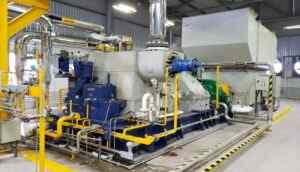A Comprehensive and understandable Introduction to all Components.

Discover the remarkable apparatus responsible for converting thermal energy into dynamic rotational motion. This ingenious device plays a pivotal role in harnessing and utilizing heat energy to propel rotor shafts, powering a range of applications across various industries, they are the heart of all power plants, and are responsible for creating a rotational movement that induces an electromotive force(emf) in the generator coil to produce electricity. The operation of the steam turbine completely depends upon the dynamic action of the high-pressure steam ejected through the nozzle.
There are four major types of turbines; water turbine, steam turbine, gas turbine, and wind turbine. Among these different designs have been developed by various scientists and engineers. Steam turbines are used in power plants, industries, and cogeneration plants.
India has emerged as one of the leading turbine manufacturing countries due to the tremendous development in the technology of design and manufacturing. Hundreds of Indian companies are leading in the international market by designing high-efficiency turbines.
We at CTMI have taken it a step further and are offering Cost effective Pressure reducing Power stations where even minute pressure drops across the PRV/PRDS can be routed through the specially Designed CTMI steam turbines and generate incidental power.
Steam Turbines in South Korea
With collaboration with manufacturers of steam turbines in South Korea, Chola Turbo has designed and adopted high steam turbine parts. Chola Turbo, in collaboration with manufacturers of steam turbines in south Korea, has innovatively designed and incorporated advanced steam turbine components. The partnership showcases Chola Turbo’s expertise to leveraging the best steam turbines in South Korea to enhance the performance and efficiency of steam turbines, positioning itself at the forefront of cutting-edge technology in the steam turbine sector.
WORKING PRINCIPLE OF A STEAM TURBINE
The nozzles are stationary and the rotor blades are dynamic. When the high-pressure steam through the nozzle hits the surface of the blades, it creates a rotating motion due to the change in the momentum of the blade. The resultant force on the blade results in the difference in the momentum of entering and exiting of the different blades. The blades are attached to the rotor shaft and convert change in momentum into rotating force.
The working principle is understood mathematically using Newton’s second law of motion by relating it with the rate of change in momentum of a high-velocity jet of steam that hits on a curved blade, that is rate of change in momentum(F), F=m(c1+c2)/t.
COMPONENTS OF THE STEAM TURBINE
The design of steam turbine components is a complex task as it involves a three-dimensional design of its parts. Numerous factors are to be considered while designing like heat, pressure, impulsive force, sensitivity, stress, strain, vibrations, number of rotations, efficiency, etc. Considering the design part there are various components of steam turbines like rotor, shaft, blades, casing, bearings, valves, nozzle, seals, trip system, governor system, casing etc. But here we will focus only on 5 main parts of the steam turbine.
1. Rotor
Steam turbines are fixed on a casing and a rotor attached with moving blades. The rotor is fitted inside the casing which consists of rows of moving blades penetrating between the rows of fixed blades. The high pressure steam flowing through the turbine passes through the fixed and moving blades alternatively. The mechanism is such that the fixed blade directs the steam at a right angle for entry into the moving blades. The utmost care has to be taken so that the rotor and its casing withstands thermal stress and the moving blades fitted with the rotor must securely withstand the high centrifugal forces.
2. Casing
Casing is required to protect the steam turbine from steam leakage. The ends of the casing where the shaft of the rotor passes a seal is required to prevent steam leakages. Leakages are not fully eliminated but can be controlled to a minimal amount.
3. Speed regulator
The speed regulator regulates the overall turbine speed. The speed turbines are designed to operate at a rated speed called synchronous speed and the turbine operating above the synchronous speed can damage the machine. At synchronous speed the efficiency of the turbine is maximum.
4. Support system
The support system also includes a lubrication system for the bearings that supports the rotor by absorbing and thrust force developed within the turbine. Any other force developed within the turbine may disturb the stability of the operation of the turbine making it reduce in the output power.
5. Governor
Speed governor or governor is a speed-sensitive control system that is integrated with a steam turbine. It works in the synchronization of the speed regulator. Both are interconnected and work by taking feedback with each other. The governor valve senses the amount of steam flow through the turbine. The steam valve is linked to the servo motor system, the turbine speed is continuously compared with the synchronous speed or reference speed that is set to the output signal of the servo motor. The speed is controlled by the amount of inlet steam and exhaust steam of the turbine.
TURBINE MANUFACTURER IN BANGALORE
Looking for the best turbine manufacturer in Bangalore for your industrial needs, Chola Turbo offers different turbines related products that include API Steam Turbines, Back Pressure Turbines, Condensing Turbines, Extraction Condensing Turbines, PRV/PRDS Replacement Solutions, Forced Lubrication System, steam turbine, geothermal steam turbine. With expertise in this field for more than two decades, Chola Turbo has fulfilled industrial needs for clients in different sectors like oil/gas refineries, steel plants, chemical plants, sugar distilleries, nuclear plants.
